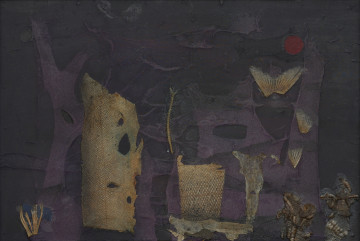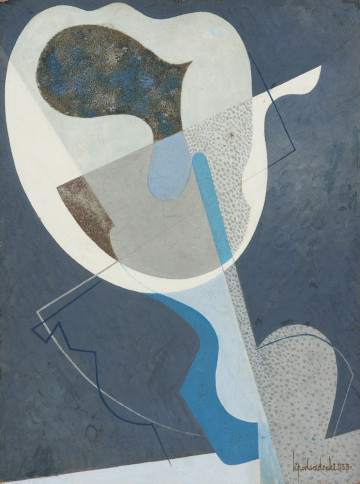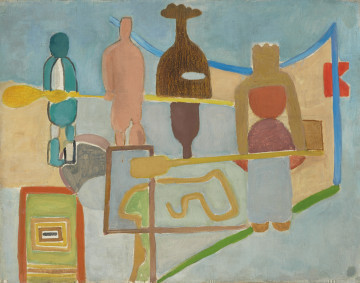
Composition with fish
1966
National Museum in Szczecin
Part of the collection: European classics of modernity
Jonasz Stern's post-war works are generally considered to be the most important interpretations of the Holocaust in world culture. The Polish artist of Jewish origin, educated in the interwar period in Lviv and Krakow, a member of the 1st and 2nd Kraków Group, from his earliest independent works confronted the problems of classical avant-garde. These included not only a new, experimental formal language (Cubism, Surrealism, New Objectivity), but also the artist's social involvement, which for Stern as an activist of the Polish Communist Party meant numerous arrests and a stay in the Kartuska Bereza (1938). Like many Krakow artists, after the outbreak of the Second World War, he returned to Soviet-occupied Lviv together with his wife, Teofila (Tońka), née Kleinberger. After the Germans entered, he was sent to the ghetto in November 1941, forced to work in the Janów Camp and the paint shop at the airport in Skniłów. Tońka, equipped with Aryan papers, remained in contact with Jonasz for some time, but their separation proved to be final. Stern escaped from a transport to the camp in Bełżec, and then, probably on the day of the liquidation of the Lviv ghetto (16.08.1943), was recaptured to be shot. When he found himself in a ditch, the executioners' bullet missed, while before the artist's eyes scrolled for ten hours the images of dying fellow prisoners. Marx said that philosophers interpreted the world differently, and the point is precisely to change it. Engels proclaimed that freedom is to be free from hunger, from misery. I go further: one should be free from superstitions. And art can only change the human psyche. To enrich it. Make people more reflective. I leave it to politicians to change the world. I have already seen its end. Then in Lviv, he confessed years later (Sztuka manifestacją życia”. Z Jonaszem Sternem rozmawiała Elżbieta Dzikowska [Art as a manifestation of life. Elżbieta Dzikowska interviewed Jonasz Stern], Radar 1986, no. 4, pp. 11-12). Compositions with animal bones, initiated by the collage Dół [The Hole] (1964), are a literal still life, but also a reflection on the possibility of re-creation in a work of art.
Szymon Piotr Kubiak
Author / creator
Dimensions
cały obiekt: height: 33 cm, width: 116 cm
Object type
painting
Creation time / dating
Creation / finding place
Identification number
Location / status

1966
National Museum in Szczecin

1933
National Museum in Szczecin

1949
National Museum in Szczecin
DISCOVER this TOPIC
Museum of King Jan III's Palace at Wilanów
DISCOVER this PATH
Educational path